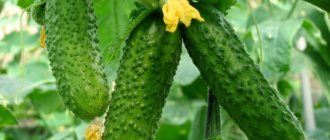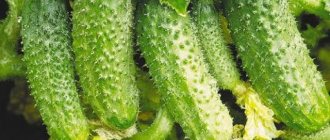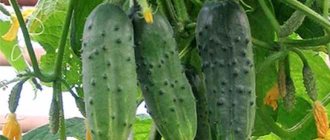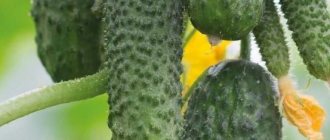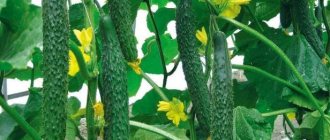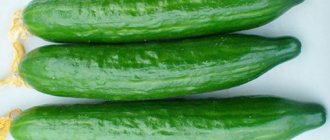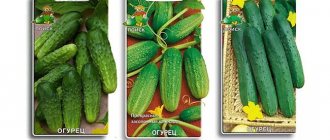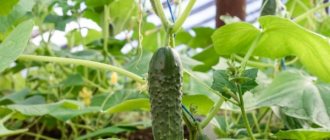Breeders have developed several varieties of bush cucumbers, popular in summer cottages and garden plots. All plants were intended by their properties for cultivation in commercial production. The bush cucumber variety Malysh for open ground celebrated its 20th anniversary several years ago, which emphasizes its attractiveness for vegetable growers.
History of selection
“Baby” was created in 1991 by V. A. Shefatov, an employee of the Volgograd station of the VNIIR named after. Vavilova RAAS. In 1994, it was included in the state register of breeding achievements of the Russian Federation.
Cultivation regions
The “Malysh” variety is zoned for the Republic of Kalmykia, Astrakhan, Volgograd and Saratov regions.
Diseases and their prevention
Often, cucumbers are affected by fungal diseases. This may occur due to contamination of the soil or seeds. As a preventative measure, it is recommended to soak the seed before planting in a weak solution of potassium permanganate. You can also water future beds with it. A saline solution (1 glass per bucket of water) is also suitable for these purposes.
The following diseases are considered the most dangerous for culture:
- gray rot;
- white rot;
- cucumber mosaic;
- olive spot;
- root rot.
Cucumber mosaic
Olive spot
Signs of white rot on cucumbers
Gray rot
Root rot
Regular monitoring, proper care and quick response when detecting the first signs of plant damage will help protect the crop from destruction. It should be remembered that a healthy and strong bush is more protected from disease than weak shoots. You need to strengthen your immune system with timely complementary foods . The nutritional composition of the soil saturates cucumbers with useful substances.
When growing cucumbers, it is important to introduce a sufficient amount of phosphorus and potassium. But nitrogen is used in a limited dose.
Description of the cucumber variety Malysh
Cucumber Baby is a universal variety that is quite resistant to temperature changes and can withstand minor droughts well. Its plants are pollinated by bees, which has a positive effect on the content of beneficial microelements in greens. The cucumber is a mid-early cucumber, fully ripens by 40-45 days after planting the seedlings.
The main features of the Malysh plant have significant differences from classical varieties:
- The length of the vine and the height of the plant are no more than 50 cm, which greatly simplifies its cultivation and makes the cucumber practical for cultivation.
- Many ovaries are formed on the Malysha bush - up to 50 fruits (up to 2.5-2.7 kg) are collected from one plant.
- The leaves of the variety are small, very wavy, dark green in color, the flowers are small, pale yellow with an orange tint.
- The length of the green variety is 9-10 cm, diameter is 2.8-3.2 cm, weight is 100-110 g.
- Its internodes are quite short, while a lot of ovaries are formed in the axil - you need to make sure that they do not overload the bush, otherwise the cucumber will stop bearing fruit.
- An ellipse-shaped cucumber, light green in color with barely noticeable light stripes, neat and attractive in appearance.
- The pulp of the fruit is medium density, very juicy, without voids, the taste of the cucumber is refreshing, slightly sweet.
Malysh is considered one of the most delicious domestic varieties; it is ideal for canning and preparing second courses. Zelenets does not lose its taste and characteristic ringing crunch even after heat treatment and canning.
Taste qualities
Each node produces up to 6 fruits. According to the description of the variety and photo, cucumbers of the Malysh variety grow up to 9-10 cm in length, have a predominantly cylindrical shape with large tubercles.
The skin of the fruit is dark green in color, with light stripes. Young cucumbers of the Malysh variety have a tender skin, while overripe vegetables have a rougher skin.
The fruit pulp is juicy and elastic, there are no voids. The gherkins are not bitter and have a pleasant taste. The average weight is 60-80 g, larger cucumbers reach a weight of 100-120 g.
Application area
Due to their versatility, the fruits are suitable for both fresh consumption and pickling and canning.
Soil requirements for planting
Light, non-acidic soil is suitable for Malyshok cucumbers. Preparing the site for laying out the beds should be done in the fall. First of all, you should correctly decide on the location. It should be well lit and ventilated. If there are tall plantings nearby, then slight shading does not interfere with the growing season and fruiting. Favorable predecessors are considered:
- tomatoes;
- early potatoes;
- corn;
- peas.
It is not recommended to grow cucumbers after zucchini, pumpkin, squash, and garlic due to the devastation of the soil.
Before planting cucumbers, the bed should be fertilized with compost.
The place for the beds needs to be dug up with the simultaneous introduction of manure (a bucket per 1 m2) . An alternative is to fertilize the soil with a mixture of potassium salt (25 g) and superphosphate (40 g). Spring work is accompanied by digging up the area and introducing ammonium nitrate (15-20 grams per 1 m2) into the soil.
Sandy and loamy soils are considered ideal soils for growing cucumbers.
Characteristics of Baby cucumbers
Many new gardeners are unaware of the existence of bush cucumbers. The length of their stems reaches only 30-50 cm. Caring for such a crop is simple, the ripening period is short. You can even recognize such plants by their names: Malyutka, Kustovoy, Korotyshka, etc. The Malysh cucumber is popular in our latitudes, the fruits of which are universal in use. The description and characteristics of this variety can be found below.
Characteristic features of the variety
The main characteristics of the variety include the following:
- the bush is short, grows up to 40 cm in height, compact, medium-climbing, the length of the lash also does not exceed 40 cm;
- the fruits are ellipsoidal in shape, covered with dark green skin with frequent tubercles;
- the size of the cucumber does not exceed 10 cm, and its weight is no more than 110 g;
- cucumbers are tied in bunches, each of which can contain up to 6 fruits.
The fruits of this variety of cucumbers have excellent taste, their flesh is juicy and tender. They are good to use both fresh and for pickling. In addition to such advantages as early ripening, good taste and resistance to diseases, one can highlight the compactness of the bushes. It is convenient to walk between them without fear of damaging the plant. You can also note the excellent presentation and good transportability. Baby cucumbers can be stored for up to 1.5 weeks without losing their appetizing appearance. Bushes of this variety actively bear fruit around the first half of July. Over the course of 14 days, cucumbers ripen very actively and amicably.
Malysh variety cucumbers are perfect for pickling
Among the disadvantages is the need to harvest every day, since the fruits quickly become overripe and lose their taste: the skin becomes rough and the pulp is tasteless.
The Kid is also capricious about the quality and quantity of watering. It does not tolerate drought, but it will not be happy with waterlogging either.
Productivity
Under favorable conditions for cucumbers, the culture on each node is capable of producing 6-7 fruits. Over the entire growing season, up to 50 selected cucumbers can be collected from one bush.
Advantages and disadvantages
The variety Malysh has already been appreciated and loved by domestic gardeners. In their reviews of the properties and qualities of grown vegetables, the following advantages are often highlighted:
- ultra early maturity, good germination;
- excellent taste without bitterness;
- universal use (fresh and for winter preparations);
- the fruits are well transported, maintaining their presentation;
- more bushes fit in a small area;
- the shortened length of the stems allows you to easily move between rows without fear of damaging the branch or fruits;
- long shelf life without loss of presentation (10 days);
- good resistance to pests and diseases.
The Malysh variety is universal: either green or salted.
The culture is not without its drawbacks, the main one of which is intensive fruiting. Harvesting is recommended daily to prevent the cucumbers from becoming overripe. The crop also loves water very much, so the watering regime cannot be violated. The Malysh variety is grown exclusively in open ground, which limits the cultivation methods.
Pros and cons of the variety
For almost 30 years of its existence, cucumber has been rated by gardeners as undemanding, easy to cultivate in open ground, and with excellent taste. According to the description, even a novice farmer can cultivate this variety. Among the disadvantages of the Baby are average fertility and short fruiting.
pros
The variety has many positive qualities that make it one of the most profitable bee-pollinated cucumbers. The most significant advantages of the Baby:
- compactness - thanks to short vines, up to 6 bushes can fit per 1 m²;
- excellent taste and versatility - cucumber perfectly complements any salad, perfect for any type of preservation;
- developed immunity - The baby is not afraid of cucumber mosaic and downy mildew;
- long shelf life - cucumber retains commercial quality for up to 10 days and does not deteriorate even during long-term transportation.
- shade tolerance - the variety is able to ripen even in a shaded area.
The vegetable is easy to cultivate; its cultivation does not require the use of expensive fertilizers and complex agricultural techniques. The baby is able to produce a decent harvest even in difficult weather conditions.
Minuses
Like any variety, Malysh did not avoid some, although not critical, shortcomings. Among the most sensitive disadvantages of the vegetable:
- low yield - on average, 15 kg/m², versus 35 kg/m² for a hybrid such as Claudia - you can increase the yield with the help of mineral fertilizers, but they must be applied carefully, only in the period before flowering;
- the short fruiting period of the Malysha is only 20-25 days, while in a greenhouse the variety can bear fruit a little longer if the ripe greens are collected in time;
- cucumber is prone to overgrowth - the greens ripen quickly, if you don’t keep an eye on them, they begin to taste bitter and become tough.
The baby does not like cultivation in greenhouses - in greenhouse conditions his immunity drops and rot begins to erode the bushes. However, the short fruiting period helps the variety avoid infection with most fungal infections.
Optimal growing conditions
The main factor influencing the growth and fruiting of cucumbers of the Malysh variety is the soil. Preparatory work is carried out in the autumn.
It is necessary to decide on the location of the future bed: the soil for cucumbers should be well lit and ventilated. There may be tall plantings nearby: slight shading does not prevent fruiting.
Baby cucumbers grow safely in beds of predecessors such as corn, peas, and tomatoes.
The soil is excessively devastated after garlic, pumpkin or zucchini, so the variety is not planted in their place.
Preparing the soil for cucumbers involves digging it up and applying fertilizer: a bucket of manure per 1 m2. Potassium salt and superphosphate are used as a replacement. The use of ammonium nitrate is mandatory: 15-20 g is enough for 1 m2.
In spring, it is recommended to fence the bed for the variety with sides and prepare trellises for formation.
Important! Malysh cucumbers grow well on loamy and sandy soils.
Features of agricultural technology of the variety
For normal growth, bush cucumbers need loose and fertile soil. Therefore, it is better to plant them in a garden bed where legumes (beans, broad beans, peas), nightshade or cabbage crops previously grew. You should not use a place for planting where there were zucchini, cucumbers or pumpkin. These vegetables have common soil requirements, and therefore common diseases and pests.
Seed selection and preparation for planting
The seeds can have any name, for example, “Baby”, “Shorty”, “Ant”, but in addition to this, the packet must have the inscription bush. Seeds should be purchased only from reliable and well-known manufacturers, otherwise there may be an unpredictable harvest result.
Preparation includes the following steps:
- Germination test. To do this, the seeds need to be immersed in salted water, after that you need to leave those that sank to the bottom, and throw away those that float.
- Disinfection. This can be done using potassium permanganate or other solutions.
- Increased germination. Seeds can be treated before planting with growth stimulating drugs. To do this, they need to be kept in the prepared solution for about 20 minutes.
Soil preparation and sowing
For seedlings, you can use purchased soil mixed with soil from the garden. You can only take garden soil, having first mixed it with humus in a ratio of 5:1, but it should not be contaminated. To play it safe, it is better to disinfect it before use, for example, sprinkle potassium permanganate on the boxes.
The bushes tolerate replanting well, so it is not necessary to plant each seed in an individual cup; to begin with, you can plant all the seeds in rows in one box. Depending on its size, this can be done in 2,3 or 4 rows. It is better to leave a distance of at least 6 cm between the rows, and about 3 cm between the plants. Before planting, the soil must be well moistened, and after planting, the top of the box must be covered with film and removed only before watering. It will increase and maintain a uniform temperature inside.
Care and planting
Usually, cucumbers sprout quickly; after 6 days, the first seedlings should appear. After the first shoots, the film must be removed and the boxes placed in a bright place, while the room temperature should be about 20 degrees. You need to water 2-3 times a week, but you need to monitor the condition of the soil.
After two leaves appear, the seedlings can be planted into pots. And a week after that, additionally feed. Planting in the ground can be done in April-May, after the appearance of 4 true leaves and the soil temperature is at least 18 degrees; before this, additional ash can be poured into the holes. When planting, you need to ensure that the distance between the bushes is no more than 30 cm, and the row spacing is 50-60 cm.
Important! The variety is bee-pollinated, so it is not suitable for growing in a greenhouse; for this purpose it is better to purchase a self-pollinating variety of bush cucumber.
Planting cucumbers Baby
The baby is planted mostly in open ground, so it is usually cultivated in late spring - early summer. Judging by the description, the cucumber is well adapted to small temperature changes and has excellent germination. Its seeds can germinate even in cool climates.
How to grow cucumber seedlings
When growing the Malysh cucumber variety in seedlings, the seeds are sown in late April or May. Good plants develop from seeds.
- Separate containers are prepared for plants, since cucumbers die if their root system is damaged;
- Soil for seedlings is purchased in specialized stores;
- If you take garden soil, it is mixed with humus, compost or peat in a 1:1:1 ratio;
- Fertilizers are added to the substrate bucket: 30 g of nitrophoska and 2 tablespoons of wood ash;
- The seeds are disinfected in a pink solution of potassium permanganate for 20 minutes, then they can be treated with any stimulating drug according to the instructions;
- Experienced gardeners advise soaking Malysh cucumber seeds in a nitrophoska solution, and then placing them in the refrigerator for 3-4 days;
- Seed planting depth – 1.5-2 cm;
- The containers are placed on a tray and placed in a warm place for the cucumber seeds to germinate.
Planting seeds
Baby seeds, as described, are planted in separate pots, ideally made of peat. The cucumber is introduced into nutritious soil from a mixture of soil with peat, humus and compost, fertilized with nitrophoska and wood ash. The seeds of the variety are buried 2 cm, watered every day, not forgetting to loosen after each watering. Immediately after emergence, the temperature in the room is maintained at 20°, after 3 days it rises to 23°.
Seedling care
Shoots appear after 5-6 days. At a temperature of 28 degrees, seeds germinate on the 4th or 5th day. For the first three days, the sprouts are kept at a low temperature of 20 0C during the day and 16 0C at night, so as not to stretch too quickly. Later, the favorable temperature for cucumber seedlings is 23 0C during the day, reduced to 17 degrees at night. The sprouts are watered with warm water - up to 30 degrees, moderately, without waterlogging the soil.
When the cucumber seedlings form 4-5 large leaves, they are transplanted into open ground. Usually - at the beginning of June. Before transplanting, the plants are hardened off for a week to make it easier to acclimatize after moving. Young cucumbers roll over, carefully removing the cups, leaving the earthen lump intact. To do this, the seedlings are watered abundantly before moving.
Warning! To prevent cucumber sprouts from stretching out on the window, in cloudy weather the temperature is not raised above 19 degrees.
Landing dates
The variety's seed material for seedlings begins to be applied in late April. In turn, the sprouted cucumber is transplanted into the ground, according to the description, at the very beginning of June - after the last spring frosts have passed. A prerequisite for the Baby is a daytime temperature above 16°, and a nighttime temperature not lower than 14°.
It is advisable to plant a few days after precipitation, while the soil is still saturated with moisture.
Site preparation
Primary preparation in the autumn period consists of cleaning the area for cucumbers, digging and replacing the top layer (20-30 cm), as well as adding chicken manure or other organic fertilizer. In the spring, 5-6 days before planting the variety, the area for the Kid is weeded and disinfected with a solution of copper sulfate or salt, after which ridges with holes are cut into which humus and ash are added. If the last rain has passed long enough, the soil under the Baby is moistened artificially through drip irrigation (6 liters per hole).
Planting in open ground
Cucumbers grow in open ground
Variety Malysh f1 can be sown in beds or using the seedling method. In warm regions with a temperate, mild climate, the first method is more often used, which does not involve subsequent picking.
Deadlines
Seeds are sown in open ground when the soil is sufficiently warm (13-15 °C) and night cold snaps no longer pose a threat. Approximate sowing dates are late May-early June. When planting later, it is recommended to cover the bed with film or agrofibre at night. This will protect the seeds from hypothermia.
Conditions
One of the main conditions for planting cucumbers in open ground is high-quality preparation of the soil and seeds. The area for growing this variety must have the following characteristics:
- the soil in the garden bed should be loose and light, well fluffy. The ideal soil for the crop is sandy loam or loamy;
- the place should be well lit. Tall plants or any structures near cucumbers will interfere with the formation of ovaries;
- Particular attention must be paid to crop rotation. It is recommended to plant the crop after potatoes, corn, legumes or tomatoes. Zucchini, pumpkin, mahogany, and garlic devastate and impoverish the soil, drawing out most of the beneficial substances from it. Therefore, it is not advisable to sow cucumbers after them;
- in the fall, the bed must be dug up and substances such as manure (bucket), potassium salt (20 g) and superphosphate (40 g) added to the soil. Spring work consists of loosening the soil and adding ammonium nitrate (15 g) to it.
Seed preparation
Malysh cucumber seeds purchased from specialized gardening stores do not require additional processing. It is better to subject those collected independently or purchased from unverified sellers to the following procedures:
- Full-bodied seeds are soaked for 15-20 minutes. in solutions of antiseptics (potassium permanganate, hydrogen peroxide). After this, the material is washed and dried;
- 1-2 days before sowing, the seeds are placed in a damp cloth and sent to a warm place for sprouts to hatch. It is important to ensure that the fabric is always damp.
Landing technology
The holes for sowing seeds are placed at a distance of 45-50 cm from each other, the interval between rows should be 40-45 cm.
Planting material is deepened into a moistened hole to a depth of no more than 2-2.5 cm.
Immediately after sowing, the bed should be covered with film or other warming material, which is not advisable to remove before the first shoots appear.
Caring for cucumbers Baby
Proper and constant care will not keep cucumbers waiting
The productivity of the crop, its ability to resist diseases, and the development of vegetables depend on the quality of the techniques for caring for young plants that vegetable growers use.
Watering
The variety requires regular but moderate watering. Gardeners recommend moistening the soil in the following ways:
- the drip method, when moisture falls directly on the root system without remaining on the nodal ovaries; You should not use strong water pressure for watering: this will expose the roots of the crop and the vegetable will become vulnerable to diseases of the root system;
- using the sprinkling method (it is carried out during especially dry times).
It is important to consider that both methods should be carried out in the morning or evening hours, when solar activity decreases. You need to use non-cold, settled water for irrigation.
Top dressing
The early ripening of cucumbers provides for a short growing season. The application of fertilizing will have a beneficial effect on the development of ovaries, their quantity and the quality of the fruit.
The first fertilization should be carried out before flowering of the crop, subsequent ones - every 10-15 days. The following are used as nutrient solutions:
- for 10 liters of water – 1 tsp. potassium sulfate, urea and superphosphate, 1 tbsp. mullein or 1 tbsp. l. humate;
- chemical and biological additives: “Rodnichok”, “Ideal”, “Fertility”, etc.
Weeding and loosening
Loosening and weeding should be carried out regularly in the garden bed. This will allow timely destruction of weeds that take away nutrients from the soil, and simplify the access of oxygen to the root system.
This will help it “breathe” and reduce the likelihood of rotting of the rhizome and root zone. Periodic loosening of the soil will allow it to retain moisture for a longer time.
Hilling
This variety requires frequent watering, which is why it may suffer from rotting. To prevent this from happening, the bushes are sprinkled with earth every 3 days. The main thing is that a hard crust does not form around the Baby. The cucumber is covered with earth to a height of slightly more than 1/3 of its height. At the same time, mulch is thrown on top around the bush, trying not to touch it. During the first hilling of the variety - immediately after planting - the bush is sprinkled with a little more than half. This way the cucumber will take root and grow stronger faster.
Formation
Since Baby Cucumbers are of bush type: the length of the shoots does not exceed 40 cm, the pinching procedure is not carried out.
To increase the yield and make the bed tidy, it is possible to tie up vines. If the shoots are not attached, they overlap each other, preventing them from receiving sunlight. Leaf plates covering the soil retain moisture in the ground, but in combination with excessive watering or bad weather conditions contribute to the development of fungal diseases.
Growing and care
Cucumbers are a moisture-loving crop. They need to be watered every 3-4 days with warm water, settled in barrels. The water temperature should be equal to the soil temperature or slightly higher.
Plants are fed at least 2-3 times per season, the first time before flowering. A teaspoon of potassium sulfate, superphosphate and urea is dissolved in a bucket of water and watered at the root. In the future, mineral fertilizers are alternated with organic ones, for example, a solution of mullein 1:10. Complex fertilizers “Humanit”, “Fertility”, “Kemira-Lux”, “Ideal”, “Agricola” are effective.
The bushes do not need shaping. Near them they carefully loosen the soil and weed out the weeds.
Harvesting and storage rules
On the 39-40th day after the emergence of seedlings above the ground, it is time to harvest. The deadline falls in the first half of July. Intensive ripening forces you to inspect the beds daily. Active fruiting of Malysh cucumbers occurs within 2 weeks. If necessary, the collected vegetables are stored in a cool place for 10 days. During this time, the fruits do not lose their qualities and presentation.
The safety of the harvested crop is influenced by the method of removing the fruit from the vine. It is important to leave a small tail on the vegetable without damaging the peel. In this case, the stems do not need to be turned over, much less swung to the sides to detect the green stuff.
Simple care rules and disease resistance of cucumbers allow the crop to be grown in regions with different climatic conditions. And early ripening guarantees a good harvest.
Growing cucumbers using the seedling method
In cold regions, where warm weather arrives late, they practice growing the Malysh cucumber variety in seedlings. This method also makes it possible to harvest fruits earlier.
Seeds for seedlings are sown in April or May with the expectation that by the time they are transferred to a permanent place, the seedlings will form 4-5 true leaves.
Seed material is prepared for planting in the same way as for open ground. But planting technology has its own nuances:
- the seeds are placed in separate containers with fertile, disinfected and moistened soil, after which they are covered with film or glass and placed in a warm place until germination;
- As a soil, you can purchase a ready-made substrate or prepare it yourself (mix humus, fertile soil and peat in equal proportions, adding wood ash and nitrophoska).
Transferring seedlings to open ground
After at least 4 true leaves appear, the seedlings can be transplanted to the site. The root system of the plant is fragile, so this must be done extremely carefully. Each seedling, together with the substrate in which it is located, is transferred into a hole prepared in advance and moistened.
Careless handling of plants at this stage can damage the rhizome of the crop, which will lead to a slowdown or suspension of the growth and development of seedlings.
Diseases and pests
A common problem with Malysh cucumbers is fungal infection. To prevent the disease, it is necessary to treat the seed and soil. The soil is disinfected by irrigating with the fungicide Redomin-gold, and spilled with a saline or manganese solution.
Diseases dangerous for Baby cucumbers are gray, root or white rot, olive spot. When spots appear on the leaf blades or the plant wilts, it is necessary to treat the plant with fungicidal and antifungal agents. It is recommended to remove the affected plant from the garden if the chances of recovery are low: this will save the remaining plants.
Important! The main way to prevent any diseases is proper care and timely feeding, which helps support the immune system of the Baby cucumber.
Root rot
Occurs when there is excess moisture and insufficient oxygen access to the roots. The main signs are wilting of foliage, yellowing and cracking of roots. Treat root rot on Malysh with a solution of chalk and copper sulfate. To do this, you need to discard the soil from the top of the root system of the variety and spray it with the above-mentioned product. In this case, the entire cucumber bed must be sprayed with a manganese solution. The best prevention against root rot is regular loosening of the soil around the bushes, as well as deep (20 cm) digging of row spacing.
Gray rot
It affects cucumbers in greenhouses or at high air humidity. Its appearance is provoked by the “greenhouse effect” - heat and humidity. Rot manifests itself as shapeless, weeping spots with a grayish coating on the leaves of the variety, spreading to the stems and fruits. Infected shoots of the Baby should be cut off by treating the cut with lime or chalk and copper powder. If it doesn’t help, use a weak solution of Bordeaux mixture. Plantings must be treated with a solution of zinc sulfate.
Spider mite
This little pest attaches itself to the Baby's leaf on the reverse side and sucks out the juices. The cucumber becomes lethargic, turns yellow and dries out, and thin sticky cobwebs appear on the foliage. The attack of the parasite is combated by treating with a medium concentration soap solution. Phytosailus is planted around Malysh’s beds, which repels ticks. To avoid the appearance of this pest in the beds, they are weeded clean every 5-6 days and the plantings are not allowed to thicken. The areas where the tick was noticed are carefully and deeply dug up in the fall - 40-50 cm.
Useful tips
Experienced gardeners who grow Baby F1 warn beginners about possible mistakes:
- In bush crops, after the formation of 5-7 leaves, the tip of the new branch is pinched off, but this cannot be done with the Baby, since the bush is compact and the length of the main branch does not exceed 40 cm.
- You need to maintain a distance between seedlings or seeds when planting. Too dense plantings are poorly illuminated by the sun, which provokes rotting of stems and fruits.
- Before planting, seedlings must be hardened off. A week before planting, the sprouts are taken out into fresh air.
- Avoid overmoistening the soil and stagnating water, otherwise the roots will rot.
- It is not recommended to sow seeds in the same bed.
Following simple care rules allows you to grow the Malyshok cucumber variety in various regions of the country. Its description speaks of its many advantages over other early ripening hybrids.
Allergy? For a cucumber?
Are you surprised? And this is understandable.
An allergic reaction to cucumber is almost exotic. This vegetable is hypoallergenic and rarely causes negative allergic reactions.
But that is precisely why, if suddenly a reaction occurs, parents cannot understand for a long time what exactly it is for.
- Sometimes it does occur in children under 2 years of age, so you cannot rule out this possibility in your child. Especially if there are people in the family who are prone to allergies;
- Or, if you give the baby a cucumber too early, when his digestion perceives any new product as a potential “enemy”. In this case, an allergic reaction may also occur.
Here I would like to draw your attention to something else:
Recently, a reaction to cucumber has become more and more common, as parents think, which is actually a protest of the small organism not to the vegetable itself, but to the harmful substances with which it was supplied during the growing process.
Therefore, the issue of choosing the right vegetable is so important.
And, if suddenly negative manifestations appear in the form of a rash, itching, runny nose or other signs of allergy after introducing the child to cucumber, you need to give up the vegetable for 2-3 weeks.
I hope now you know everything about how to introduce cucumber into your baby’s complementary foods and not harm your little one. Accustom him to this wonderful vegetable correctly, and the benefits will be obvious!
- Vegetables for first feeding
- WHO complementary feeding table
- How to feed a child correctly?

